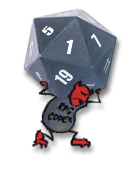Burning Bridges
Enviado de meu SM-G3502T usando Tapatalk
Yes, the many people who love non-games because they hate games rate it a success.















For me, I see it like Banner Saga, good for what it is, i.e. simple, low-budget kickstarted game best enjoyed in small doses.






























A list of games which have made me swear the most:
5) Syndicate (original)
4) Prince of Persia: The Sands of Time
3) Mario Kart
2) Quake III: Arena
1) Bedlam
After two decades of unabashed f-bombing, I’m trying to curb the frequency and volume of my bad language, given I share the house with a two year old who currently seems capable of imitating anything instantly. Bedlam destroyed my good intentions, and the air has lately been bluer than a vaguely avant-garde musical stageshow starring men with painted faces and bald caps.
It’s The Banner Saga does FTL does Mad Max, but it seems to have combined all three of those things’ cruel streaks: the regularity of loss and punishment, and the sheer number of balls to juggle, makes it a litany of suffering for the first few hours. Eventually a combination of practice and luck of the draw persistence saw me get over Bedlam’s particularly large hump, but Jesus Christ. I’m entirely accustomed to permadeath games going to hell, but the sustained assault here is something else entirely.
If you’re not losing fuel then you’re losing food, or power, or passengers, or fighters. Something is always in crisis, and that crisis is regularly interrupted by relatively lengthy turn-based battles which each involve their own crises. It is all manageable, especially with practice, but by God it gets its kicks in first. During one attempted campaign, I’m pretty sure I sustained a single low moan for a full 45 minutes. Couldn’t hold onto anything, every dial in the red, every bit of good fortune immediately punished. I got better. It got better. Just don’t go into it expecting a chance to find your feet before the hard work begins.
It’s instantly appealing from afar, but in practice Bedlam’s inspirations and foundations are perhaps a little too obvious. Structurally, it’s FTL in the desert, with all the resource management and 2D map-clicking that entails, while the turn-based combat is very much like a more range-centric Banner Saga, right down to the mixture of human and giant fighters. Nothing’s especially wrong with this, but there is a prevailing sense that this was a game assembled from parts of other games rather than having a strong spirit of its own.
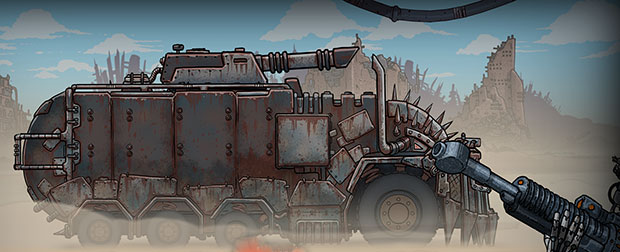
What individuality it has is all down to the cheerfully lurid art style, which comes across like a Saturday morning cartoon for adults. It looks simultaneously crisp and blobby, every character like an action figure-to-be, and it’s pulpy to the point of celebratory, where most recent post-apocalyptic games can tend towards the grim. Even exaggerated death sequences – burned to the bone by acid vomit, atomised by nukes, Chaplinesque frozen-bodied collapse from headshots – are too playful to be gruesome. Not playful enough to stop me shouting ‘fuuuuuuuuuuuuuuuuuuuuuuuuck yooooooooooooooooooouuuu’ when yet another stalwart fighter is one-shot murdered, however. It looks lovely, and the giant mutant characters especially are a delight, like ‘toonish Warhammer 40,000 models.
Sadly the writing can’t quite keep up with the appearance. While perfectly functional and never as irritatingly referential and memey as the very similar but far less accomplished Convoy, it’s just a bit flat, at odds with the gleefulness of the art. Loading screens contain lame jokes, and very occasional NPCs drone out screens of superfluous lore which isn’t at all reflected (or needed) by the simple in-game structure of mutants vs cyborgs vs AI. Fortunately, the bulk of the game is far more straight-to-the-point, and characters (whether enemies or potential allies) who are described in just a few lines of punchier text make much more of an impression. Comic book post-combat screens with Street Fighterish one-liners are the overwhelming highlight.
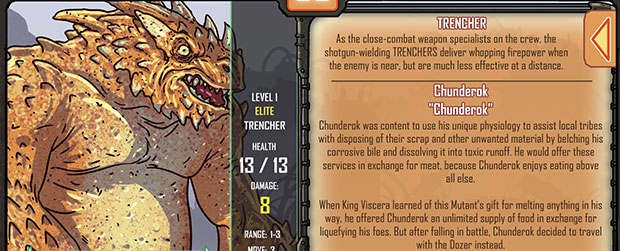
Somewhat surprisingly, what doesn’t leave a big impression is assumed star of the show, the Dozer. It’s an apparently huge APC that shuttled your fighters and several hundred ever-unseen civilians across the lethal desert. It’s front and centre of the marketing and its role is much discussed in-game, but all it really does is offer some combat aid (analagous to player spells in a 4X game) from off-map, and appear as a static icon on the progress map. It isn’t that ever-present, precious, vulnerable entity that FTL’s spaceship is, perhaps because the game has dropped vehicular damage modelling in an attempt to strike at least some difference from its great inspiration. Whatever the reasoning, it feels like a shame that there’s no opportunity to see the Dozer in action or care about its fate.
It can run out of fuel – leading to game over unless you’re prepared to do something icky to your passengers – but that’s the only sense of peril to it. It’s an inventory screen, really. The aforementioned passengers, of which there are 1000 at the start of a playthrough, are essentially unseen too: they’re just a number at the top of the screen. With all scale thus absent, the essential Battlestar Galactica-on-wheels concept just can’t breathe.
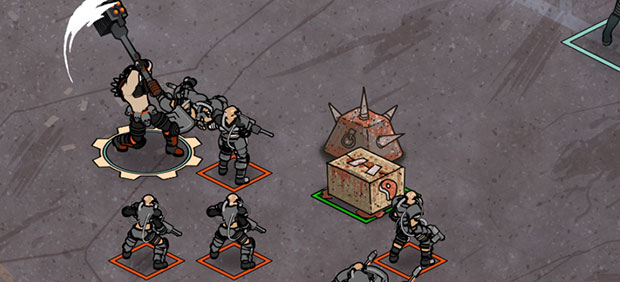
Far more tangible and fragile are your combat characters, who once dead are lost forever. Split across four classes (longest range = high damage low health, shortest range = low damage high health), they’re initially a collection of fairly indistinguishable grunts, but their ranks will be augmented with hulking, heavy-hitting boss monsters if you can first defeat those bosses. This is a great system, encouraging you to seek out danger even when you’re already on the back foot, because the possible gains are immense. Taking down a boss involves a huge sigh of relief, both because you’ve survived and because your dwindling army just received mammoth reinforcement.
It takes a lot of practice and not a little luck to reach the point where you can do even that at all reliably though, let alone survive the huge fights towards the end game. The attrition rate is traumatic at first, making those initial XCOM forays seem like the height of kindness. To a certain point, Bedlam is fair, which is to say tragedy is a consequence of your decisions rather than something simply heaped upon you. But a system whereby you only get two actions per turn, no matter how many characters you have in play, is extremely limiting – sure, you can potentially take out one or sometimes two enemies, but that won’t leave any actions to move an endangered character to safety.
The enemy’s in the same boat, although after a few turns they can activate ‘blitz’, which gives them three actions, but there were many situations in which I felt it was impossible not to lose. In hindsight, I can see that they all came down to recklessness or a lack of forethought and with that acceptance comes the realisation that this is chess with guns rather than XCOM or Fallout. The moves you don’t make matter perhaps more than the moves you do.
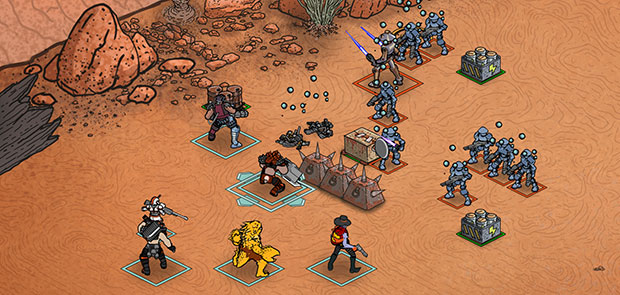
A faintly aggravating targeting and range system denies Bedlam’s combat the purity it’s striving for. A sniper can’t shoot under a certain range, bodies and boxes and anything block line of sight, a shot will reach from this square but not the one right next to it…the rules are fixed but not entirely transparent, and I spent more time than I’d like panning the cursor around while painstakingly trying to figure out where I’d have to move my guy to if he was to shoot anything, rather than simply knowing from experience what was and wasn’t going to work. I had to do the same for the enemy’s range and LOS too – to know whether I was about to move a unit into a square an opponent’s sniper could hit involved far too much clicking back and forwards.
It sounds minor on paper, but in practice all of that clicking goes into the mix of what I felt, for some time, to be straight-up cruelty on the game’s part. Eventually, the logic of the systems becomes decipherable but the trouble is that the game doesn’t offer a chance to get a sense of the world and the controls, or more importantly form a loose plan of action for progression, before it’s kicking your feet out from under you.
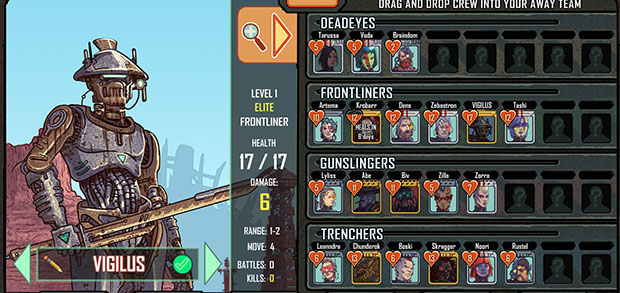
As I said, I managed to haul myself over the hump eventually, making my way through a few fights without losing almost my entire crew, and winding up with precious, precious veterans in the process. Then I hit a bug which meant a) two or three of my guys spawned on top of each other in combat and could not move and b) none of the enemy would move at all. So it was a cakewalk. And it happened almost every other fight. Reloading the game didn’t sort it, and I didn’t want to start over, so I levelled up my guys, grabbed endless resources, and the late-game boss fights were no trouble at all. I feel a bit guilty, but it does leave me in a position to declare that, if Bedlam’s early and mid-game does make you swear at the skies, what happens when you reach your apparent destination may well lead to ragequits.
That helpful bug wasn’t the only one I encountered. I was playing pre-release code, but the build arrived just two days before release, so I doubt you’ll be getting anything significantly different today. Lock-ups, disappearing objectives and savegames which lost huge chunks of progress were the main offenders, plus it all broke down entirely at what I think was the end proper. It’ll most likely be fixed, but I can’t pretend that these problems haven’t soured the experience as a whole.
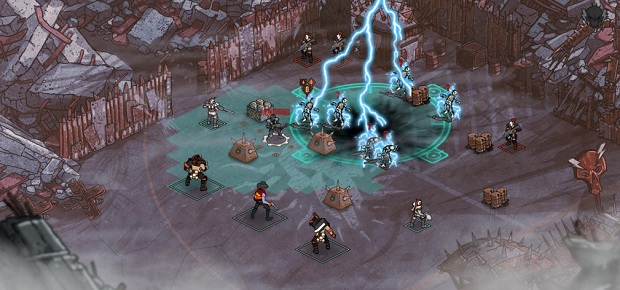
So you’ll have to view my closing comments through the lens of that confession, but: I dig the way Bedlam looks and I enjoy the Chess-like restrictions of its combat, but I feel like it hasn’t quite got the soul it needs. I don’t feel like I’m visiting a place (or riding through it in a giant, iron-clad deathtank), but rather that I’m looking a collection of art and words created to meet a brief. Bedlam borrows so much from FTL, but doesn’t manage to capture the lonely vulnerability. The character-led chattiness of The Banner Saga is absent too, with the story propelled instead by what I can only describe as flavour text.
I enjoyed Bedlam, without a doubt: it looks great, it motors along and the fights are thoughtful as well as punishing. I don’t necessarily feel like I’m going to go back to it though. While it looks lovelier than FTL, it doesn’t have the drama and tension which keeps me committed to that game of endless space danger. It’s the best alterna-FTL we’ve had so far, but I question whether simply being an alternative is enough. Perhaps I’ll be back to see what fresh secrets and OTT characters I can dig up from the desert once the bugs are fixed, however.















Damn,will pass then.BS was atrocious in every aspect.

I still don't understand all the hatred towards TBS. Do you people hate chess as well?Damn,will pass then.BS was atrocious in every aspect.
I still don't understand all the hatred towards TBS. Do you people hate chess as well?

That's actually one of the cooler things about Banner Saga's combat system. It encourages you to think about which targets to prioritize, since getting rid of an enemy can be as much of an asset as a liability. It also means combat can stay tense until the very end, since the amount of turns the enemy gets doesn't change until the pillage phase.Combat was most tolerable part of the game,still on design level it was retarded.Does you opponent get to move 2 times in chess when you take a piece

That "retarded" icon feels right at home in your post. TBS has single-action turns alternating between you and your opponent (the opponent being the game AI in this case). Killing enemy units doesn't give the opponent any bonus actions.Does you opponent get to move 2 times in chess when you take a piece
That's not really the best strategy. The bigger dredge units just summon another dredge when they reach low health, enemies still have abilities that are not dependent on their health, and leaving enemies alive means more work down the line (since you have to reach them again, which may require a few turns spent on moving around and re-positioning). Killing units also gives you a party-wide willpower resource.lol no you just don't kill enemies until all of them are low
That's not really the best strategy. The bigger dredge units just summon another dredge when they reach low health, enemies still have abilities that are not dependent on their health, and leaving enemies alive means more work down the line (since you have to reach them again, which may require a few turns spent on moving around and re-positioning). Killing units also gives you a party-wide willpower resource.
You can't even position your dudes? Nice game.Playing right now. Is there an "End Turn" button?
Whoa! Went into battle and this is the starting positioning that the game puts me in.

